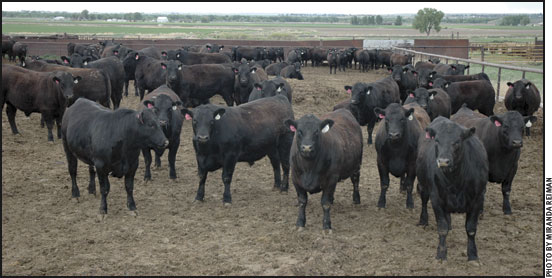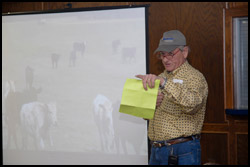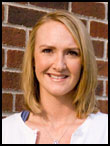MARKETING...

Average Doesn't Cut It On Grids
It's a pretty well-recognized fact: If you want grid premiums, your cattle have to be better than average.
Most people don't sell on a value-based system unless they have reasons to believe their herd genetics and management will result in high-quality beef. But even among ranchers who sell on a grid, the plant average factor — part of the formula used to derive grid pricing — is not as well understood.
"It affects producers in two ways," says Clem Ward, Oklahoma State University professor emeritus: "One, in terms of premiums and discounts and, two, in the form of base price." Read more.

Dillon Feuz
In the Cattle Markets
Corn market risk
The government found more bushels of corn on hand and increased the expected ending 2011 inventory to 730 million bushels (bu.) with the May 11 report. That was an increase of 65 million bu. from trade expectations and an increase of 55 million bu. from the April estimate. For the short term, that has sent corn prices declining for the day.Even though current plantings are lagging behind last year's planting pace and the average for the last five years, the latest "World Agricultural Supply and Demand Estimates" (WASDE) report expects corn planting to be 92.2 million acres, up 4 million acres from last year. Read more.
Weather Affecting Most Every Aspect
of U.S. Cattle Market
Weather in the United States has been making a complicated 2011 cattle market even cloudier, ultimately affecting everyone from producers to consumers.
"Just about everything has been affected, from supply impacts to demand inputs to input market impacts," said Derrell Peel, Oklahoma State University Cooperative Extension livestock marketing specialist.
Beef demand by the American public has been negatively affected by the cold, wet weather across much of the United States this spring, resulting in a lack of good outdoor grilling conditions in a number of states. Even in many warmer climates, drought conditions and the potential for wildfires have resulted in burn bans restricting outdoor activities and cooking. Read more.
CAB® 3QQ
Three quick questions with Phil Bass.

Phil Bass
The company recently announced the creation of a new position: corporate meat scientist. Phil Bass, a native Californian with a doctorate from Colorado State University, was serving on the international sales team, but his heart has always been in digging into data. He eagerly looks forward to the new responsibilities, and I caught up with him to visit about what this new title means. Read more.
Cattle Producers Join Forces for Better Sales
Cattle producers and buyers are finding a win-win method of marketing cattle in the Cattlemen's Exchange and Homeplace Producer Sales.
 Mississippi State University (MSU) Extension is partnering with several organizations and sale barns to offer auctions in Winona and Hattiesburg for cattle that may never pass through either of those cities. Cattle remain on their home farms while buyers cast bids based on written descriptions of the cattle and video technology.
Mississippi State University (MSU) Extension is partnering with several organizations and sale barns to offer auctions in Winona and Hattiesburg for cattle that may never pass through either of those cities. Cattle remain on their home farms while buyers cast bids based on written descriptions of the cattle and video technology.
"These board sales are open to anyone in the state, and any sale barn can be involved as well," said Jane Parish, Extension beef cattle specialist. "The sales work to everyone's advantage, including the cattle's." Read more.

Sara Snider
The Source
Western Video Market data from fall 2010 sales support premium of AngusSource®-tagged calves.
There's a lot to think about this time of year. Spring and fall tend to be the busiest times of year in the AngusSource department. April was our largest enrollment month ever, with 21,440 head enrolled in AngusSource and 3,699 enrolled in Gateway. We talk with producers from across the country on a daily basis. And we get to hear about their operations. This year more than ever there has been a lot of news to share. Read more.
Study Examines Local Impact
of
Small-Scale Meat Processors
Investing in Iowa's small meat processing plants could have positive local impacts in rural communities, according to a new report by Iowa State University (ISU) economist Dave Swenson.
Swenson analyzed the state's meat-processing facilities for the Marketing and Food Systems Initiative at the Leopold Center for Sustainable Agriculture. Swenson's report, "Exploring Small-Scale Meat Processing Expansions in Iowa," is available on the Leopold Center's website at http://www.leopold.iastate.edu/research/
marketing_files/Swenson_Small-Meat.pdf.
Iowa is a prominent leader in the nation's meat-packing industry, particularly in cattle and hogs. Yet the state's farms have declined over the past two decades, and growing numbers of Iowans live and work in urban centers. Rural decline raises the question of whether small-scale meat-processing plants can continue to compete with larger-scale processors.
Small plants in Iowa are generally more labor-intensive than large ones, with less return on the labor. Swenson's study found that small plants require significantly more employees, providing 13.3 jobs for every million dollars of meat, compared to the statewide average of 4.7 jobs. Employees in small facilities typically receive less pay, although there's room to develop skilled trades through training programs.
With increasing demands for specialized meat, like grass-fed cattle and pasture-raised hogs, small processing plants have the opportunity to fill profitable niche markets. Consumers who buy from local plants fuel job creation and keep more money within the community, a concept called the "local multiplier effect." Swenson's study suggests that investments to improve the efficiency of small plants can make them more competitive, as well as give a boost to the local economies of nearby rural communities.
The Leopold Center highlighted Swenson's research in the Iowa Local Food & Farm Plan, which offers recommendations to the Iowa state legislature for nurturing robust local foods production.
Swenson also completed a related study to provide data for the Iowa Local Food & Farm Plan that shows how increased demand in Iowa's metropolitan areas for locally grown fruits and vegetables can have a positive impact on rural communities. That report can be found at http://www.leopold.iastate.edu/research/
marketing_files/Swenson_Fruit_Veg.pdf.
Angus Calendar
To view the Angus Calendar, a complete list of
Angus sales, click here.











